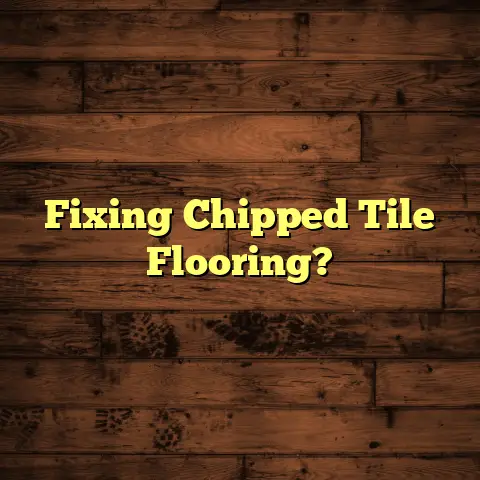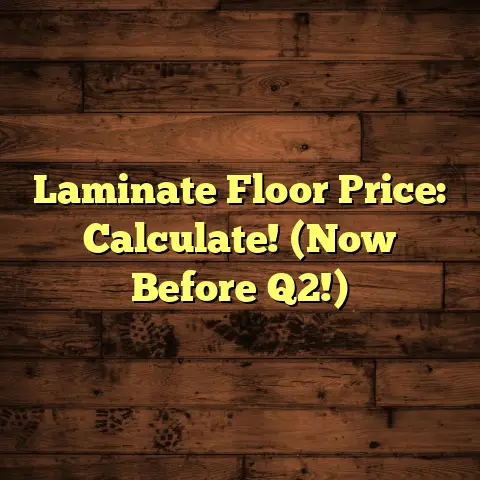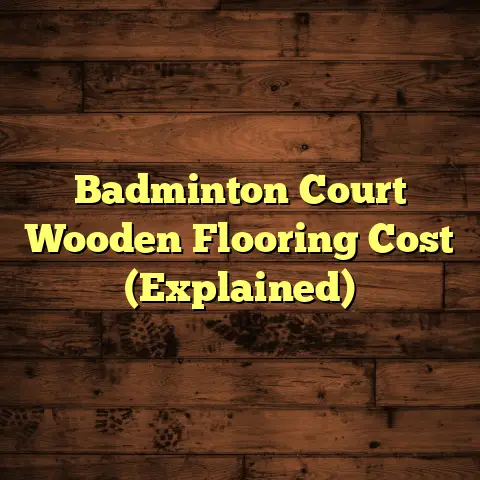Quietly Walk On Creaky Wood Floors? (3 Fixes Now!)
Are you tired of your wood floors sounding like a haunted house with every step you take?
Many homeowners think creaky floors are just a given when you have wood flooring – an unavoidable sign of age and wear.
They believe that the only solution is a costly and disruptive renovation.
But I’m here to tell you that’s simply not true!
As a flooring contractor with years of experience, I’ve seen it all.
And I’m excited to share some practical solutions that can significantly reduce or even eliminate those annoying creaks.
Get ready for a quieter, more peaceful home.
In this article, I’ll walk you through three effective fixes for creaky wood floors.
You’ll learn the root causes of the problem and simple techniques to address them.
Let’s get started!
Section 1: Understanding the Cause of Creaky Floors
So, what’s actually causing your floors to sound like an old pirate ship?
It’s usually a combination of factors, and understanding them is the first step to fixing the problem.
The Usual Suspects
-
Temperature and Humidity Changes: Wood is a natural material, and it expands and contracts with changes in humidity and temperature.
Think of it like this: in the summer, when it’s humid, the wood absorbs moisture and expands.
In the winter, when the air is dry, it loses moisture and shrinks.
This constant movement can create gaps between boards.
It will also affect the subfloor, leading to creaks when you walk on them.
According to the Forest Products Laboratory, wood can expand or contract by as much as 5% across its width.
-
Improper Installation: I’ve seen some real horror stories when it comes to floor installations.
If the floor wasn’t installed correctly to begin with, you’re setting yourself up for problems down the road.
Gaps, misaligned boards, and insufficient nailing or gluing can all lead to creaks.
A study by the National Wood Flooring Association (NWFA) found that over 90% of flooring issues can be traced back to improper installation techniques.
-
Wear and Tear: Like anything else, wood floors age over time.
The constant foot traffic, furniture, and general use can take their toll.
Fasteners can loosen, wood can warp, and the subfloor can weaken, all contributing to those unwelcome noises.
Anatomy of a Creak
To really understand what’s going on, let’s take a quick look at the anatomy of your wood floor:
-
Subfloor: This is the foundation of your floor, usually made of plywood or OSB (oriented strand board).
It’s attached to the joists and provides a stable surface for the flooring.
If the subfloor is loose or damaged, it can cause the flooring above to creak.
-
Joists: These are the structural beams that support the subfloor.
They run parallel to each other and are typically made of wood.
If the joists are spaced too far apart or are not properly supported, they can flex and cause the floor to creak.
-
Flooring Boards: These are the actual wood planks that you see and walk on.
They’re attached to the subfloor with nails, screws, or glue.
When these fasteners loosen or the boards rub against each other, you get creaks.
A Personal Anecdote
I remember one homeowner in particular, Mrs. Davis, who was driven to her wit’s end by her creaky floors.
Every step she took, especially at night, sounded like someone was breaking into her house.
She was constantly worried about waking up her kids or disturbing her neighbors.
After inspecting her floors, I found that a combination of humidity changes and poor installation was to blame.
The boards had expanded and contracted over time, creating gaps and loose spots.
With a few strategic fixes, we were able to silence her floors and restore her peace of mind.
Section 2: Fix #1 – Tightening Loose Floorboards
Alright, let’s get down to business!
The first fix we’re going to tackle is tightening loose floorboards.
This is often the simplest and most effective solution for minor creaks.
Identifying the Culprit
The first step is to find the loose boards that are causing the problem. Here’s how:
-
Listen Up: Walk slowly across the floor, paying close attention to where the creaks are coming from.
Try to pinpoint the exact location of the noise. 2. Apply Pressure: Once you’ve identified a creaky spot, apply pressure with your foot or hand.
Can you feel the board moving or shifting?
This is a good indication that it’s loose. 3. Visual Inspection: Get down on your hands and knees and take a close look at the floor.
Do you see any gaps between the boards?
Are any of the boards sticking up slightly or moving when you step on them?
Tools and Materials You’ll Need
- Drill with various drill bits
- Wood screws (choose the right length for your floor thickness)
- Wood glue
- Caulk gun (optional, for filling gaps)
- Safety glasses
- Dust mask
- Hammer (if you need to tap boards into place)
The Tightening Process
-
Lift the Board (If Necessary): If the board is significantly loose or warped, you may need to carefully lift it up.
Use a pry bar or a putty knife to gently lift the edge of the board.
Be careful not to damage the surrounding boards. 2. Apply Wood Glue: Squeeze a generous amount of wood glue onto the subfloor beneath the loose board.
Make sure to cover the entire area where the board will make contact. 3. Re-Screw the Board: Position the board back in place and use your drill to drive screws through the board and into the subfloor.
Choose screws that are long enough to penetrate the subfloor but not so long that they go all the way through.
Space the screws evenly along the board, about every 6-8 inches. 4. Wipe Away Excess Glue: Use a damp cloth to wipe away any excess glue that squeezes out from under the board. 5. Caulk Gaps (Optional): If there are any noticeable gaps between the boards, you can fill them with caulk.
Choose a caulk that matches the color of your floor.
Safety First!
- Wear safety glasses to protect your eyes from flying debris.
- Use a dust mask to avoid inhaling sawdust.
- Be careful when using power tools. Read the instructions and follow all safety precautions.
- Don’t over-tighten the screws. You could strip the screw heads or damage the wood.
Success Story
I had a client, Mr. Johnson, who was convinced he needed to replace his entire living room floor because of the creaks.
But after spending an hour tightening loose boards and adding a few screws, his floors were as quiet as a mouse.
He saved thousands of dollars and couldn’t believe how simple the fix was.
Section 3: Fix #2 – Adding Shims
Okay, so tightening the loose boards didn’t completely eliminate the creaks?
No problem! Let’s move on to Fix #2: adding shims.
This is a great solution for filling gaps between the floorboards and the joists.
What are Shims?
Shims are thin, tapered pieces of material (usually wood or plastic) that are used to fill gaps and provide support.
They’re like tiny wedges that you can slide into tight spaces to stabilize and level things.
When to Use Shims
Shims are most effective when the creaking is caused by the floorboards rubbing against the joists.
This often happens when the subfloor has settled or the joists are uneven.
Finding the Right Spots
-
Listen Carefully: Just like with the first fix, start by listening to where the creaks are coming from.
Try to pinpoint the exact location of the noise. 2. Feel for Movement: Apply pressure to the floor in the creaky area.
Can you feel any movement or vibration?
This is a sign that there’s a gap between the floorboard and the joist. 3. Look for Gaps: If possible, try to look underneath the floor (from the basement or crawl space) to see if you can spot any gaps between the floorboards and the joists.
How to Shim Like a Pro
- Gather Your Supplies: You’ll need shims (wood or plastic), wood glue, a utility knife, and a hammer.
- Prepare the Shims: If you’re using wooden shims, you may need to trim them to the right size and shape using a utility knife.
- Apply Glue: Apply a small amount of wood glue to the shim.
-
Insert the Shim: Carefully slide the shim into the gap between the floorboard and the joist.
You may need to use a hammer to gently tap it into place. 5. Trim the Excess: Once the shim is securely in place, use a utility knife to trim off any excess material that’s sticking out.
Advantages of Shimming
- Cost-Effective: Shims are relatively inexpensive.
- Minimal Disruption: Adding shims is a fairly quick and easy process that doesn’t require major demolition.
- Effective: When used correctly, shims can eliminate creaks and stabilize your floor.
Real-Life Example
I worked with a homeowner, Sarah, who had a particularly annoying creak in her kitchen floor.
After inspecting the area, I discovered that the subfloor had settled slightly, creating a gap between the floorboards and the joists.
By strategically adding shims in a few key locations, we were able to completely eliminate the creak.
Sarah was thrilled with the results and couldn’t believe how simple the fix was.
Potential Pitfalls
-
Don’t Overdo It: Be careful not to force the shims in too tightly.
This could damage the floorboards or the joists. * Use the Right Material: Choose shims that are appropriate for the type of flooring you have.
Wooden shims are generally best for wood floors, while plastic shims can be used for other types of flooring. * Secure the Shims: Make sure the shims are securely glued or fastened in place.
Otherwise, they could eventually work their way loose and the creaks will return.
Section 4: Fix #3 – Lubricating Floorboards
Alright, let’s move on to our final fix: lubricating the floorboards.
This might sound a little strange, but it can actually be a very effective way to reduce friction and noise.
The Science of Lubrication
The idea behind lubricating floorboards is to reduce the friction between the boards as they rub against each other.
When the boards are dry, they tend to stick and then suddenly release, causing a creaking sound.
By adding a lubricant, you can allow the boards to slide more smoothly against each other, eliminating the creak.
Types of Lubricants
-
Talcum Powder: This is a classic solution for creaky floors.
Talcum powder is a fine, slippery powder that can be easily applied between the boards.
I’ve found that it works best for minor creaks and squeaks. * Paraffin Wax: This is a slightly more aggressive lubricant that can be used for more stubborn creaks.
Paraffin wax is a solid wax that can be rubbed into the gaps between the boards.
It provides a longer-lasting lubrication than talcum powder.
How to Lubricate Your Floors
-
Clean the Area: Before you apply any lubricant, make sure the area is clean and free of dust and debris.
Vacuum or sweep the floor thoroughly. 2. Apply Talcum Powder: Sprinkle a small amount of talcum powder along the seams between the creaky boards.
Use a soft brush to work the powder into the gaps. 3. Apply Paraffin Wax: Rub a stick of paraffin wax along the seams between the creaky boards.
Apply firm pressure to ensure that the wax gets into the gaps. 4. Wipe Away Excess: Use a clean cloth to wipe away any excess lubricant from the surface of the floor. 5. Test the Area: Walk across the area and listen for any remaining creaks.
If necessary, repeat the process.
Tips for Maintaining a Lubricated Floor
- Reapply as Needed: The lubricant will eventually wear off, so you may need to reapply it every few months.
-
Monitor for Effectiveness: Pay attention to whether the lubricant is still working.
If the creaks start to return, it’s time to reapply. * Avoid Overdoing It: Don’t apply too much lubricant.
This could make the floor slippery or leave a messy residue.
Success Story
I had a client, Mrs. Rodriguez, who had a creaky hallway floor that drove her crazy.
She had tried everything to fix it, but nothing seemed to work.
Finally, I suggested lubricating the floorboards with talcum powder.
To her surprise, it worked like a charm!
The creaks disappeared, and she was finally able to walk through her hallway in peace.
Conclusion
So, there you have it! Three effective fixes for creaky wood floors.
Remember, creaky floors don’t have to be a permanent problem.
With a little bit of effort and the right techniques, you can silence those annoying noises and enjoy a quieter, more peaceful home.
I encourage you to take action and implement these solutions in your own home.
Start by identifying the cause of the creaks and then choose the fix that’s most appropriate for your situation.
And don’t be afraid to experiment!
Sometimes it takes a little trial and error to find the perfect solution.
I’d love to hear about your experiences with creaky floors and the fixes that have worked for you.
Share your stories and tips in the comments below.
Let’s create a community of homeowners who are dedicated to maintaining their homes and achieving a quieter, more comfortable living environment.
Ultimately, the satisfaction of achieving a quieter home is well worth the effort.
By taking proactive steps in home maintenance, you can protect your investment, improve your quality of life, and enjoy the peace and quiet you deserve.
So go ahead, tackle those creaky floors and start enjoying a more peaceful home today!





